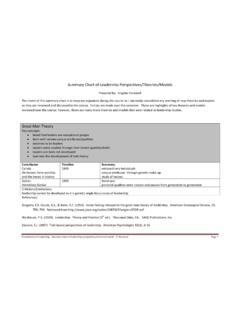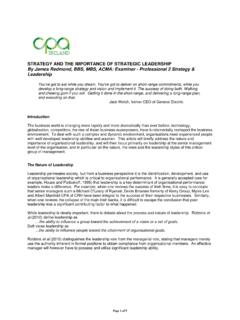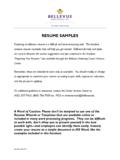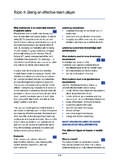Transcription of Six Emotional Leadership Styles - ESNZ
1 Six Emotional Leadership Styles Choosing the Right Style for the Situation Imagine that you work with a positive, charismatic leader. She's excited about the future of the organization, and she shares this excitement with her team. She makes sure that people understand how their efforts contribute to this future, and this inclusion sparks loyalty and intense effort in the team. Generally, morale and job satisfaction are high, because team members feel that they're making a difference. However, some people in her team don't respond well to this style of Leadership . And when there's a crisis, she struggles to get some of them to focus on short-term objectives. She could be more effective by varying her approach to Leadership , depending on the situation; and she could do this by using "six Emotional Leadership Styles ," each of which is useful in different circumstances. In this article, we'll look at these six Emotional Leadership Styles . We'll explore each style, and we'll look at the situations where each is most useful.
2 We'll also explore how you can develop the skills needed to use each style effectively. The Six Emotional Leadership Styles Daniel Goleman, Richard Boyatzis, and Annie McKee described six distinct Emotional Leadership Styles in their 2002 book, "Primal Leadership ." Each of these Styles has a different effect on people's emotions, and each has strengths and weaknesses in different situations. Four of these Styles (Authoritative, Coaching, Affiliative, and Democratic) promote harmony and positive outcomes, while two Styles (Coercive and Pacesetting) can create tension, and should only be used in specific situations. Goleman and his co-authors say that no one style should be used all of the time. Instead, the six Styles should be used interchangeably, depending on the specific needs of the situation and the people that you're dealing with. Note: You'll be able to choose the best style to use if you know how to "read" others and the situation you're in. This is where it's useful to improve your listening skills, learn how to understand body language, and improve your Emotional intelligence.
3 We'll now examine each style in more detail. 1. The Authoritative (Visionary) Leader People using the Authoritative Leadership style are inspiring, and they move people toward a common goal. Authoritative leaders tell their teams where they're all going, but not how they're going to get there they leave it up to team members to find their way to the common goal. Empathy is the most important aspect of Authoritative Leadership . When to Use It Authoritative Leadership is most effective when the organization needs a new vision or a dramatic new direction, such as during a corporate turnaround. However, it's less likely to be effective when you're working with a team more experienced than you are here, democratic Leadership is more likely to be effective. This Leadership style can also be overbearing if you use it too often. How to Develop It To develop an Authoritative style, focus on increasing your expertise, vision, self-confidence and empathy. Get excited about change, and let your team see your enthusiasm.
4 You also need to convince others of your vision, so focus on improving your presentation skills. Example Imagine that, in order to reach some aggressive sales goals, you've decided to overhaul the way that your department connects with new clients. The techniques and processes you've developed are radically different from the ones that your people are used to. As you tell your team about the new process, you can't help but be excited. You believe that these changes will make a real difference to your results, and you want your people to succeed. Your team immediately picks up on your excitement and sincerity, and they get excited too. They know it's up to them to use the new system to make things happen, and they're willing to put in the extra work needed to learn new skills. 2. The Coaching Leader The Coaching Leadership style connects people's personal goals with the organization's goals. A leader using this style is empathic and encouraging, and focuses on developing others for future success.
5 This style centres on having in-depth conversations with employees that may have little to do with current work, instead focusing on long-term life goals and how these connect with the organization's mission. This style has a positive impact on your people, because it's motivating, and it establishes rapport and trust. When to Use It The Coaching style should be used whenever you have a team member who needs help building long-term skills, or if you feel that he or she is "adrift" in your organization and could benefit from a coaching or mentoring relationship. However, coaching can fail when it's used with an employee who is not making an effort, or who needs a lot of direction and feedback here, pacesetting or Coercive Leadership may be more appropriate. How to Develop It To develop a Coaching style, learn how to engage in informal coaching and mentoring. It's also important to get to know the people on your team. When you know your people, you're better able to see when they need guidance or advice.
6 Walk around to keep in touch with their needs. Example Jim, a new hire on your team, is having trouble fitting in to his new role. He's only been with the organization a month, but you can tell he's dissatisfied. Your organization requires "face time" at the office, and Jim misses the freedom of telecommuting, as he did at his old job. You also get the feeling that he'd like a position with more responsibility. You meet with Jim, and you help him see that being in the office five days a week does have distinct advantages over telecommuting. For instance, showing up every day allows him to bond with the team and network with colleagues who could turn into strategic allies in the future. You also encourage him to use your organization's immense training library, which he can visit in his lunch break to learn the skills he needs for a promotion. To inspire and motivate Jim, you assign him projects that will stretch his skills and knowledge base. Instead of being overwhelmed, he expresses excitement about the opportunity.
7 After your talk, Jim takes your advice and starts making the most of his time in the office. He works on his projects with dedication, impressing both you and your boss. 3. The Affiliative Leader The Affiliative Leadership style promotes harmony within the team. This style connects people together, encouraging inclusion and resolving conflict. To use this style, you must value the emotions of others, and put a high value on their Emotional needs. When to Use It Use this style whenever there is team tension or conflict, when trust has been broken, or if the team needs to be motivated through a stressful time. How to Develop It Leaders who use the Affiliative style are highly focused on emotion. So, learn how to resolve conflict and how to be optimistic. Example After a difficult year, Sarah's boss has finally been asked to leave her department. Although she was proficient at her job, her management style was dictatorial. It didn't matter what she had to do or whose feelings she hurt meeting department goals was her top priority.
8 Sarah's been asked to take over her position, and, although she's excited about the opportunity, she's now in charge of a team that is emotionally battered and untrusting. Sarah decides to focus on her team's Emotional needs before doing any work on department goals and future projects. Her first few meetings are just spent talking. She allows everyone to open up about how their old boss made them feel. Every person on the team is allowed time to vent. The group quickly realizes that although they went through their own tough times, they all experienced similar things. After two meetings, the atmosphere in the team is better and more open to new relationships. Because their Emotional needs were met first, the group is now ready to focus on new projects and goals. 4. The Democratic Leader The Democratic Leadership style focuses on collaboration. Leaders using this Leadership style actively seek input from their teams, and they rely more on listening than directing. When to Use It This style is best used when you need to get your team on board with an idea, or build consensus.
9 It's also effective when you need your team's input. The Democratic Leadership style shouldn't be used with people who are inexperienced, lack competence, or aren't well informed about a situation. It's best to ask for input from team members who are motivated, knowledgeable and capable. How to Develop It To develop a Democratic Leadership style, involve your team in problem solving and decision making, and teach them the skills they need to do this. You should learn active listening and facilitation skills. Example Your department has lost money over the past two quarters, and you're anxious to reverse this you know that if you can't figure out how to make your department profitable soon, something radical (and unpleasant) will have to be done to stem the losses. You call a meeting with your team and explain the situation. You ask them if they have any ideas that could turn the department around. Then, you give them the floor: For the rest of the meeting, all you do is listen. Your team members talk through their options, and you reach a consensus on what to do next.
10 5. The Pacesetting Leader The Pacesetting Leadership style focuses on performance and meeting goals. Leaders using this Leadership style expect excellence from their teams, and often the leader will jump in him or herself to make sure that goals are met. The Pacesetting style doesn't coddle poor performers everyone is held to a high standard. While this can be a successful style, it can have a negative effect on the team, leading to burnout, exhaustion and high staff turnover. When to Use It The Pacesetting Leadership style is best used when you need to get high quality results from a motivated team, quickly. How to Develop It Because the Pacesetting style focuses on high performance, learn how to improve the quality of your team's work using techniques like Six Sigma and Kaizen. Train your people properly, and engage in high-performance coaching to help them become as effective as possible. You may also want to work on your motivation skills, so that you can get the best from your people.










